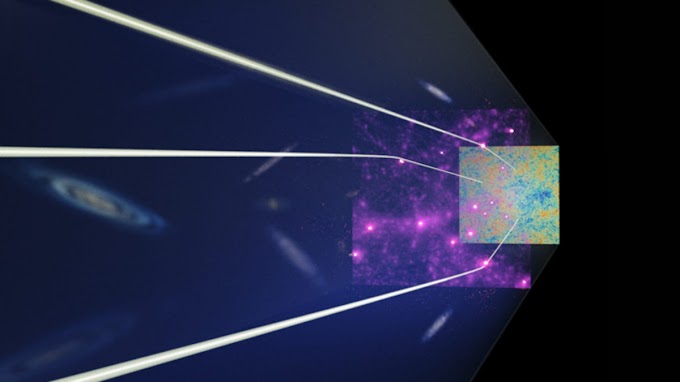Do you know about one of science's biggest unsolved mysteries of our Universe — Where is all the Dark-Matter ? What is this Dark-Matter ? From where this Dark-Matter have come ?
 |
| An artist's illustration of radiation residue from the Big Bang distorted by dark matter 12 billion years ago ।। Credit : Reiko Matsushita |
All we know, there is Dark-Matter in our Universe .
All the Galaxies, including our Milky-Way, are spinning too rapidly . So, physics predicts that — everything inside of these Galaxies should be flung outward . But, that's not happening . Sun, Earth, all the Planets of our Solar-System, You, Me are safely anchored . Therefore, scientists thinks for something like a Halo shape, must surround Galaxies to protect them from a falling apart .
Whatever comprises those boundaries is called Dark-Matter . We can't see it, we can't feel it . And we don't even know if Dark-Matter is one thing . Dark-Matter is the epitome of elusive . We only that it exists .
Scientists have some interesting ways of identification the effects of Dark-Matter on our Universe . After all we deduced Dark-Matter's presence in the first place by noticing how it holds Galaxies Together .
Also Read :: India's AstroSat Telescope observes ‘live’ formation of Dwarf Galaxies around Milky-Way & Andromeda
Scientists took advantage of principle, announcing remarkable new findings about Dark-Matter on 1st August, 2022, Monday . By the help of a toolkit composed of wraped space, cosmic residue left over from the Big-Bang and powerful astronomical instruments — The Scientists detected a deep space zone of previously unobserved Dark-Matter Halos . Each situated around a very ancient Galaxy and it is protecting the Galaxy from living out a Merey-Go-Round nightmare .
The Dark-Matter whirls, according to a study on the find published in Physical Review Letters, date back 12 Billion Years , just under 2 Billion Years post Big-Bang . It might very well make them the Youngest Dark-Matter rings ever observed by humanity , the Authors suggest, and potentially the prelude to Cosmology's next chapter .
Hironao Miyatake , Nagoya University and Author of the Study stated — “ I was happy that we opened a new into that era . 12 Billion Years ago, things were very different . You see more Galaxies that are in the progress of formation than at the present, the first galaxy clusters are starting to form as well ” .
Warped Space ? Cosmic Residue ? What's this ??
Approximately, more then a century ago, Albert Einstein coined his famous theory of General Relativity . There he predicted that – super strong Gravitational Fields stemming from Massive quantities of matter, would literally wrap the fabric of SpaceTime . His prediction turned out to be correct . Modern Cosmologist uses a concept of Gravitational Lensing to study very faraway Galaxies and other Phenomena in the Universe .
Let's try to understand the working principle of Gravitational Lensing — Imagine, there are two galaxies . Galaxy-A is in the background and Galaxy-B is in the foreground . Basically, when the light from A passes by B to get to your eyes, that luminescence gets distorted by Galaxy-B's matter, dark or not . Such distortion often magnifies faraway Galaxies, kind of like a Lens .
Then you've to do a reverse calculation . You can can do with this light wrap to figure out — how much Dark-Matter surrounds Galaxy-B . If there is too much Dark-Matter, you'll see a lot more distortion than expected from Visible-Matter . But if there is not so much Dark-Matter, the distortion would be much closer to your prediction . This method has worked well but has a caveat . Standard Gravitational Lensing only allows Scientists to identify Dark-Matter around Galaxies, which sit something like 8 - 10 billion Light-Year away, at maximum . This is why, because — as you look deeper and deeper into the Universe ; visible light becomes harder to harder to interpret . Even turning to Infrared Light that's totally invisible to human eyes . What this means – visible light distortion signals for Dark-Matter studies become far too faded beyond a certain point to help us analyse the hidden stuff .
Also Read :: “Powerful Storms” in North Pole of Jupiter : NASA's Juno Probe captured stunning pictures
Here Miyatake came up with a workaround . We can't notice standard light distortions to detect Dark-Matter . But what if there's another type of distortion we can see ? As it turns out, there is Microwave Radiation , released from the Big-Bang . It was formally known as CSB Radiation .
“ Look at Dark-Matter around distant Galaxies ” — Masami Ouchi, Cosmologist of Tokyo University and co-author of the study stated . “ It was a very crazy idea . No one realised we could do this . But after I gave a talk about a large distant Galaxy sample, Hironao came to me and said it may be possible to look Dark-Matter around these Galaxies with the CMB Radiation ” . In essence, Miyatake wanted to observe how Dark-Matter Gravitationally Lensed our Universe's first light .
From the Big-Bang
“ Most researcher use force Galaxy to measure Dark-Matter distribution from the present to 8 billion years ago ” — Yuichi Harikane , Asst. Professor, Tokyo University and co-author of the study stated . “ however, we could look further back into the past because we use the more distant CMB to measure Dark-Matter . For the first time, we were measuring dark matter from almost the earliest moments of the Universe ” . To arrive to add their results, the new study team first collected data from observations taken by the Subaru Hyper Suprime-Cam Survey . It led them to identify more than 1.5 millions Lensed Galaxies , which could be tracked to 12 billion years ago . Then they collected data from ESU's Planck Satelite on Big-Bang Microwave Radiation . Gathering all the data together, the team could study if and how those Lensed Galaxies distorted the Microwaves .
Also Read :: James Webb Space Telescope ( JWST ) is trying to Proff Hawking's Theory of Multiverse . Check out How ?
“ These result gives a very consistent picture of galaxies and their evolution, as well as the Dark-Matter in and around Galaxies, and how this picture evolves with time ” — Neta Bachall , Professor of Astrophysics , Princeton University and co-author of the study stated .
Point to be noted, the scientists emphasized their study finding this Dark-Matter from the Early-Universe doesn't seem to be as clumpy as our present physics models suggest .
Miyatake stated — “ Our finding is still uncertain, but if it is true, it would suggest that the entire model is flawed as you go further back in time . This is exciting because if the result holds after the uncertainties are reduced, it could suggest an improvement of the model that may provide inside into the nature of Dark-Matter itself ”.
And next up, the Study Team desires to discover even in advance areas of space by way of tapping into Vera C. Rubin Observatory's Legacy Survey of Space and Time .
“ LSST will allow us to observe half the sky . I don't see any reason we couldn't see the Dark-Matter distribution, 13 billion years ago. ” — Said Harikane, co-author of the study .












